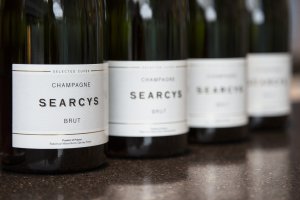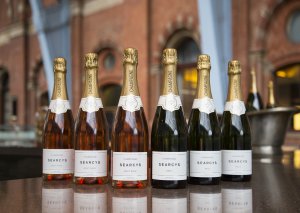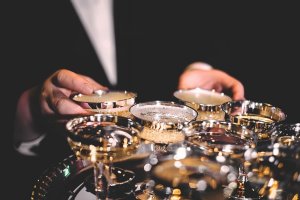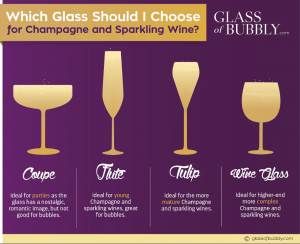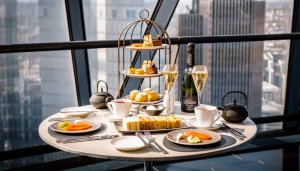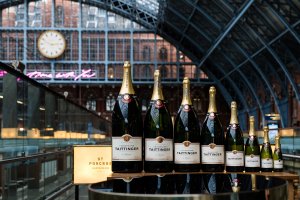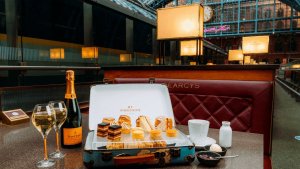-
Searcys Champagne Journey
19 October 2020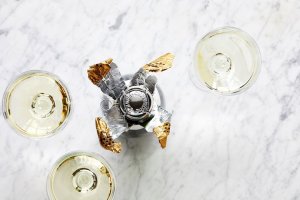
The UK is still the world’s second-largest consumer of Champagne, behind only the French, buying around 27 million bottles each year.
We caught up with Searcys drinks ambassador Bruno Pelletier, to find out how Champagne has managed to keep its sparkle over all these years.
THE STORY BEGINS…
Celebrated local wines have been produced in the Champagne region for over a thousand years, but the drink we now know and love didn’t officially gain its fizz until the 1700s.
The effect, accidentally caused when low temperatures in the region’s cold winters, saw the fermentation process prematurely halted, before beginning again in warmer weather building pressure from carbon dioxide, was replicated intentionally, as the popularity of sparkling Champagne grew.
Already the talk of London society, following the arrival of influential epicurean Charles de Saint-Évremond in 1661, it is thought the English were some of the first to see added bubbles as a desirable trait
EARLY HISTORY
The end of the 17th century, Benedictine monk Dom Pérignon, from the Abbey of Hautvillers, made his first appearance. Legend has it that he introduced spectacular improvements in how the wine of Champagne was made. These included using carbon dioxide – a bubble-forming gas created in wines containing residual sugar after extra fermentation during spring.
During the reign of Louis XV, too much red wine was produced, which resulted in bringing destitution to the winemakers. Yet the new white, sparkling Champagne had won over the King’s court and was rapidly gaining in popularity. France was hit by a crisis in 1864 when a grapevine pest called phylloxera, carried by an aphid from the US, destroyed the whole Champagne region. During the turbulent years that followed the phylloxera epidemic, to protect wine production in the long-term, the government decided to reduce the number of Champagne-producing areas – resulting in the farmers’ revolt of 1907.
The subsequent creation of AOC (Appellation d’Origine Contrôlée) regulation sealed quality control in the area of Champagne. An AOC area is born from an alliance between the natural environment and human ingenuity. From this alliance comes an AOC product with unique, inimitable characteristics, wine so different that it complements rather than competes with others – and has a particular identity that adds additional value.
1856
Traceback the UK’s love affair with Champagne and you’ll find much of the credit goes to one special lady, Queen Victoria. Having discovered her love of the Perrier-Jouët drier style “brut” Champagne, she insisted on it being served at all her banquets at venues including Blenheim Palace from 1856, with society’s movers and shakers all scrabbling to follow suit.
1896
Having been appointed the Royal Warrant as caterers towards the end of the 1800s, Searcys made a note of the elegant new to serving Champagne when entertaining, in the introduction to their 1896 catalogue:
“With the advance of the Nation’s prosperity and culture, entertaining has not only become more general but almost one of the necessities of social life.”
At the end of the 19th century, Searcys Wine and Spirit Department let it be known that they bought directly from distillers and growers in vast quantities.

The first mention of Searcys Own Cuvée dates back to 1893. That year’s catalogue called attention to the Champagne specially prepared for and shipped by Searcys, the De Garnier et Cie 1893 vintage at 66s a dozen bottles.
A separate ‘Price List of Champagnes’ gave 36 brands of which five printed in heavy gold type. There was the De Garnier; George Goulet, speciality shipped at 74s a dozen; Ernst Irroy 1898 at 78s a dozen. The Leroux was the cheapest at 4s a bottle; the Charles Heidsieck Dry Monopole 1893 at 132s a dozen was the most expensive.
In the 1930s it was not the custom at dances to serve Champagne at the running buffet in the ‘sitting out’ rooms, but only at the sit-down supper which took place half-way through the dance and served at the small tables in the Supper Room. There were always long queues for supper, and it needed a considerable amount of tact and a degree of firmness on the part of the caterer in charge to prevent the situation from getting out of control. One of the company directors, John Searcy Physick, approached each occasion with ‘the enthusiasm of a producer and the shrewdness of a psychologist.”

Searcys 21st century own brut and rosé cuvées are enjoying phenomenal success and are very popular with guests across all our venues.
20TH CENTURY
While the popularity of Champagne continued to rise throughout the early 20th century, the devastation caused by both World Wars saw vineyards close and production slow. Churchill’s love of Champagne, “Champagne should be dry, cold, and free” – Winston Churchill.
Churchill loved Champagne. He was fond of saying that a glass lifts the spirits and sharpens the wits – but “a bottle produces the opposite effects.” Pol Roger was famously his favourite Champagne house; however, Perrier-Jouet has also discovered the records leading them to believe that their Champagne was served at Churchill’s wedding. It had been his choice from the 1920s. Indeed, when he attended a lunch at the British Embassy in Paris in November 1944, after its liberation by the Allies, he and Odette Pol Roger became friends for the rest of his life.
1998
Things begin to change in the world of traditional Champagne. The late 90s see Nyetimber release their 1993 Classic Cuvée, the first English Sparkling Wine using a true champagne blend. It was brilliantly received, proving not only that English Sparkling Wines could be good, but that they could be great, with many blind tastings favouring Nytember.
2007
Searcys opens the world’s longest champagne bar in London’s iconic St Pancras Station. Taking centre stage in the historic station’s wonderful Art Deco surrounds, the drinks menu features the most renowned and respected houses in Champagne.
2018
The UK’s first Champagne School is launched by Searcys in London, under the management of Searcys champagne ambassador Joel Claustre. The Champagne School is a ground-breaking platform to showcase small English sparkling wine producers as well as the established big Champagne houses.
SEARCYS CUVÉE
We are very proud to present Searcys own Brut and Rose Cuvees, expertly developed by Champagne specialists, our chefs and mixologists. Our 21st century own brut and rosé cuvées are enjoying phenomenal success and is very popular with guests across all our venues.
BRUT
Nose: Elegant, complex and fruity nose. Aromas of peach and plum with notes of citrus. Palate: Elegant and fruity with notes of toasted bread and citrus, our Searcys Selected Cuvee Champagne shows an unctuous texture on the palate balanced with a fresh, crisp finish.ROSE
Red fruits dominated by strawberry and white flowers aromas, with dried apricot and almonds notes.
Palate: Mix of red fruits flavours with strawberry, raspberry and redcurrant. The texture is soft and creamy, followed by a long and complicated finish.“Too much of anything is bad but too much Champagne is just right.” F Scott Fitzgerald
Whether you are an accomplished connoisseur who knows a prestige cuvée from grand cru or an absolute beginner who is keen to discover more about your favourite sparkling wines, Champagne and sparkling wines have been Searcys passion since founded in 1847.
MAGNUMS TASTE BEST
Searcys is known for its signature magnum to pour and its most extensive selection of magnums in our Champagne Bar at St Pancras. Champagne poured from a magnum has matured more slowly, which means it tastes better. Its flavours are complex and harmonious, and with 12 glasses per bottle, it’s great for larger groups. The ultimate showpiece, magnums make perfect Instagram moments, and there are hundreds of ideas on Pinterest for those who want to make them into a lamp or candle holder after the party.
Order a magnum at one of our bars and restaurants, or for your private or business occasion across our portfolio of restaurants and bars and events venues.


COUPES OR FLUTES?
Reminiscent of the glitz and glamour of the 1920s, the saucer-shaped coupe is the classic glassware first designed for Champagne. Its wide bowl allows the drink to ‘open up’ giving the Champagne a fuller taste. For those who prefer a bit more fizz, experts recommend the flute, which enhances the flow of bubbles and Champagne’s aroma. Whichever you choose, both can be held by the stem to keep them cool and refreshing.
OUR PARTNER CHAMPAGNE HOUSES
We are partnered with some of the best Grand Marques in the world. Our range is designed to deliver a wide selection of Champagne by the glass and bottle for restaurants, bars and events. With seven different categories available, from Brut to vintage, we have plenty of variety.

LANSON
Established in 1760, Lanson is the only Grande Marque to produce a certified Organic Champagne. It was were awarded a Royal Warrant in 1901 by Queen Victoria, making it the first official supplier to the Royal Household, which it still supplies today. Its wines are the perfect balance between freshness, fruitiness and finesse.

TAITTINGER
Family owned and managed since 1734; this is one of the last major Champagne houses to remain in family ownership. It’s also the first Champagne House to develop an English sparkling wine from grassroots, to launch in 2023. Taittinger’s Cuvée is matured for up to 36 months, which is twice the legal requirement for the region, providing complexity and higher quality.

Veuve ClicquotFounded by one of the first businesswomen, Madame Clicquot, innovation has always been at the heart of this Champagne house. In 1775 it was the first house to commercialise rosé Champagne, in 1810 it was the first to create a vintage blend in Champagne and in 1816 it invented the riddling process. Famous for its predominance of Pinot Noir, Veuve Clicquot has one of the most extensive vineyards in Champagne with 393 hectares.

DOM PÉRIGNON
This vintage Champagne belongs to the house of Moët & Chandon, serving as the house’s prestige Champagne since 1921. It’s named after Dom Pérignon, a 17th-century cellar master at the Benedictine abbey in Hautvillers, who introduced corks. These were fastened to bottles with hemp string soaked in oil to keep the wines fresh and sparkling. Dom Pérignon has a unique mineral character that gives it a tactile sensation on the palate.
- ABOUT SEARCYS
- About Searcys
- News
- All News
- Searcys x Sociability Blog
- Raise a Glass: Celebrate English Wine Week with Searcys
- a Day of Insight and Impact at the ESG Forum at 116 Pall Mall
- Searcys and the Barbican host isla’s “Made Possible Festival” A One-Stop Event Sustainability Summit
- Plan the Ultimate Summer Soirée with Our Spectacular London Venues
- Private Dining Now Available at the Barbican Conservatory
- A Fresh Taste of Artful Hospitality at the National Gallery
- Reservations open for Locatelli
- The Business of Events: A Westminster Dinner to Remember
- Restaurants and Bars
- Event Venues
- EVENT SPACES
- All Locations
- {10-11} Carlton House Terrace
- 30 Euston Square
- 41 Portland Place
- 116 Pall Mall
- Barber-Surgeons Hall
- Battersea Power Station
- Carpenters’ Hall
- Church House
- Gray’s Inn
- Horizon 22
- IET London: Savoy Place
- National Army Museum
- No. 11 Cavendish Square
- One Moorgate Place
- Saddlers’ Hall
- Searcys at The Gherkin
- EVENT SPACES cont.
- Searcys Bar and Brasserie at Surveyors House
- Stationers’ Hall
- St Pancras Bar & Brasserie
- Surveyors House
- The Barbican
- The HAC
- The Inner Temple
- The Portrait Restaurant By Richard Corrigan
- The Roman Baths and Pump Room
- The Royal Institution
- The View, Royal College of Surgeons of England
- Vintners’ Hall
- Event Types
- SEARCYS ROLLS-ROYCE
- Let Us Find Your Venue
- Event Catering
- What’s On
- Contact Us
- ABOUT SEARCYS
- About Searcys
- News
- All News
- Searcys x Sociability Blog
- Raise a Glass: Celebrate English Wine Week with Searcys
- a Day of Insight and Impact at the ESG Forum at 116 Pall Mall
- Searcys and the Barbican host isla’s “Made Possible Festival” A One-Stop Event Sustainability Summit
- Plan the Ultimate Summer Soirée with Our Spectacular London Venues
- Private Dining Now Available at the Barbican Conservatory
- A Fresh Taste of Artful Hospitality at the National Gallery
- Reservations open for Locatelli
- The Business of Events: A Westminster Dinner to Remember
- Restaurants and Bars
- Event Venues
- EVENT SPACES
- All Locations
- {10-11} Carlton House Terrace
- 30 Euston Square
- 41 Portland Place
- 116 Pall Mall
- Barber-Surgeons Hall
- Battersea Power Station
- Carpenters’ Hall
- Church House
- Gray’s Inn
- Horizon 22
- IET London: Savoy Place
- National Army Museum
- No. 11 Cavendish Square
- One Moorgate Place
- Saddlers’ Hall
- Searcys at The Gherkin
- EVENT SPACES cont.
- Searcys Bar and Brasserie at Surveyors House
- Stationers’ Hall
- St Pancras Bar & Brasserie
- Surveyors House
- The Barbican
- The HAC
- The Inner Temple
- The Portrait Restaurant By Richard Corrigan
- The Roman Baths and Pump Room
- The Royal Institution
- The View, Royal College of Surgeons of England
- Vintners’ Hall
- Event Types
- SEARCYS ROLLS-ROYCE
- Let Us Find Your Venue
- Event Catering
- What’s On
- Contact Us
Saved Venues0Stay Connected with Searcys
Sign up to receive updates on exclusive events, restaurant offers, and more from Searcys.
